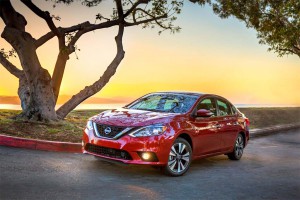
Nissan set a new record for March sales with this year's tally. Overall, sales were up across the board for automakers last month.
While there were a few signs of weakness, the U.S. auto industry managed to keep its sales momentum going in March, the industry delivering a number of new records, notably including the price American buyers paid for their new vehicles last month.
Though industry giants Toyota and General Motors ran into some strong headwinds, delivering only modest, year-over-year increases, other automakers, including Ford, Fiat Chrysler and Honda, posted strong gains for March, Nissan sales reaching an all-time record. Audi, among European makers, reported its 63rd consecutive monthly increase even as the sibling Volkswagen brand continued to feel the impact of its diesel emissions scandal.
The strong industry performance continued to reflect a surge towards SUVs, crossovers and other light-truck models that now collectively account for about three of every five vehicles sold in the U.S., with little indication recent rises in fuel prices will slow that momentum.
“Customers continue buying high-end SUVs and trucks, helping the Ford brand increase its average transaction prices by more than $1,600 per vehicle in March – nearly double the industry average,” said Mark LaNeve, Ford vice president, U.S. Marketing, Sales and Service. But LaNeve noted the momentum was visible “across our entire product portfolio,” including sedans and other traditional passenger car models.
American Honda, which has been expanding and updating its crossover line-up, saw its sales surge 9.4% for the month. Ford and crosstown rival Fiat Chrysler posted 8% gains. But the smaller Detroit maker actually was expected to deliver even better numbers overall, with its Jeep brand up 15%.
“Strong Jeep and Ram brand sales gave us a fast start to the important spring selling season and extended our year-over-year monthly sales gains to six full years,” said Reid Bigland, senior vice president – Sales, FCA – North America. “As consumers continue to shift their buying preference toward utility vehicles and trucks, they are walking directly into the FCA wheelhouse.”

Despite being owned by Volkswagen, Audi appears to be exempt from the scorn of its parent company. Sales rose for the 63rd consecutive month in March.
(Analysts warn about the dangers of rising incentives. For more, Click Here.)
Among imports, Nissan posted a 13% sales increase, the mainstream brand’s best month ever, noted Judy Wheeler, vice president, Sales, Nissan Division U.S. “Nissan Division sales were led by March record-breaking sales of the Sentra and our best ever sales month for light trucks and crossovers,” she added.
One of the few real surprises for the month, Toyota reported its sales slipped by 2.2 %, while its upscale Lexus brand saw a 2.8% dip during March of 2016.
GM managed to stay in the black for the month, though with only a modest 0.8% increase. Still, the company professed satisfaction with the results because it managed to nab an additional point of retail marketshare. GM has been shifting strategy in recent months, focusing on retail, rather than fleet sales. In March, it let its rental car volume decline by 35%, with its overall fleet sales down to 23.3% of the month’s total. On the retail side, it gained 6.9% for March.
Two brands embroiled in a major scandal achieved notably different results in March. Audi said its sales increased by 7.5%, its 63rd consecutive monthly increase. Audi has largely skated by unscathed, despite the fact that it has had to halt sales of its diesel models because they don’t comply with U.S. emissions standards.
But it’s Volkswagen that has been hardest hit by revelations it used hidden software to cheat on diesel emissions tests. The German brand reported its own sales dropped by 10% in March.
(Click Here for details about FCA’s possible addition of a second midsize truck.)
The industry benefited not only from strong March sales, but also the fact that U.S. buyers have been shifting to more expensive light trucks, often loading them up with costly options. According to analysts at Kelley Blue Book, the estimated average transaction price, or ATP, for light vehicles sold in the United States last month came to a record $33,666. New-car prices were up $645 from March 2015.
“March average transaction prices reveal continued increases for nearly every manufacturer, with the industry average up 2% year-over-year,” said KBB analyst Tim Fleming. “While this may seem like good news for automakers and dealers, incentive spending continues to rise within the industry and offset part of this strength.”
Another sign worrying analysts is the fact that consumers have been stretching payments out over longer periods, often to 72 to 84 months, noted Fleming, “which will likely delay the purchase cycle for their next vehicle.”
TrueCar Inc. estimates that U.S. new vehicle sales totaled $55 billion in March, up 9.7% from a year ago and the highest ever recorded for the month. It also marks the auto industry’s 27th consecutive month of year-over-year revenue expansion.
Record average transaction prices last month helped automakers post a $4.8 billion gain in revenue versus March 2015 despite a projected 10.4% increase in incentive spending.
(To get a first look at the new Tesla 3: the EV maker’s big bet, Click Here.)
“The first quarter of the year appears to have ended nicely for automakers, marked by healthy consumer demand and solid transaction price growth,” said Eric Lyman, TrueCar’s vice president of industry insights. “For the quarter, we expect sales to outpace the year-ago period by 5% and each month in 2016 has set a year-over-year revenue record.”
(Paul A. Eisenstein contributed to this report.)
